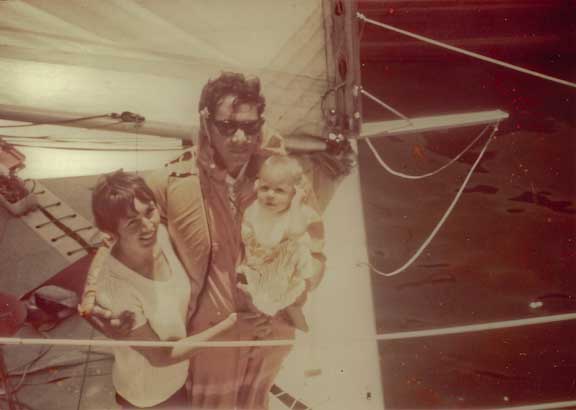
There has been a lot of dialog recently on SetSail about cruising multihulls. Since we were working on some old photos for the kids on this very subject we thought a blog on our early days of cruising might be in order. The photo above was taken 40 years ago. That’s Elyse in Steve’s arms. Two of us are standing on the 32′ D class cat Beowulf V. This was our first “family cruiser” as evidenced by the guest aboard (Linda is considered crew).

We’ll go into the antecedents of Beowulf V in a later post. She was obviously a day sailor, but a good sea boat too as evidenced by this photo on the way to Ensenada during the roughest Ensenada Race in history (half the monohull dropped out and two ocean racing cats flipped). Beowulf V made the trip without incident in 12 hours and 27 minutes, finishing a full eight hours ahead of the next boat. Sailmaker Ric Taylor is crewing. Nobody said a cruising boat has to be slow.
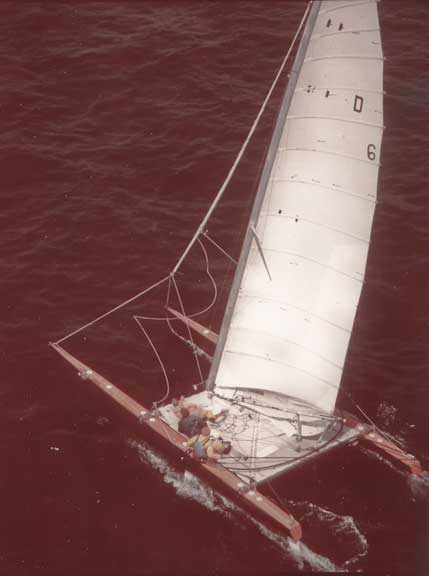
Beowulf V was not really designed in the classic sense. She rather evolved from experience and a garage full of boat parts left over from years of C-class catamaran development and racing. The beams, daggerboards, and rudders were from a recently deceased C-cat called (surprise) Beowulf lV.
The sail was a cast off of Beowulf lll, and the mast was the result of a trade with another C-cat owner.

The hulls were made in the tortured ply method used for Tornado cat hulls in those days. Skip Hawley, a Tornado builder, added 12 feet to his deck jig and we basically stretched the Tornado hull keeping the freeboard the same. She was 32′ LOA and 16 feet wide. The complete boat, including tools and ground tackle, weighed 732 pounds hanging from a single point scale.
Note the wind sock on the committee boat upper left. True wind is about eight knots. We are broad reaching with a true wind angle of 150 degrees. The trim of main and reacher on this deep angle will tell you about boat speed, fifteen knots or just under twice wind speed. Apparent wind is so far forward the reacher is flown to leeward to open its slot with the main.
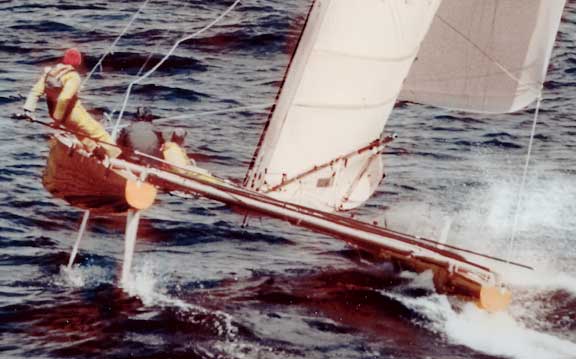
We always wanted the weather hull out of the water, so the crew, Norm Riise and Rick Taylor, are sitting inboard. Norm is braced with the main traveler control in hand. Steve is on the wire, steering with the best view of puffs and waves. Note the behind the back steering technique on the tiller extension.
With the deeply V shaped bows Beowulf V had excessive directional stability. Altering course up or down with puffs had to be done in advance of bow loading. Once she had accelerated any angle of attack changes on the rig had to be done with the sail adjustment rather than by altering course. The loads were so high that this was a slow process. If the skipper anticipated the required course change then speed would be maintained. But if you were late, and the traveler needed adjustment, speed would drop quickly. It took enormous concentration to keep her in the groove.
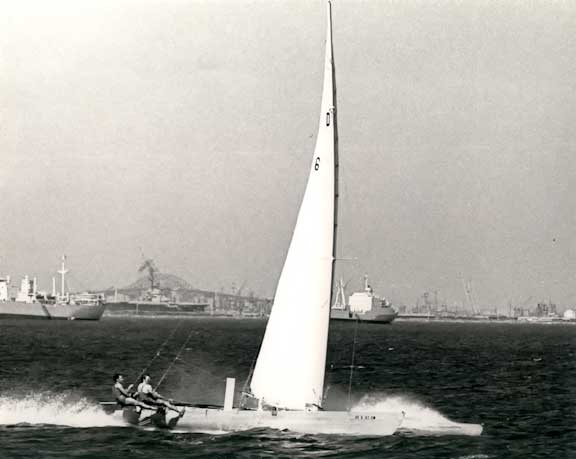
The photo above was taken during Pacific Multihull Association speed trials in 1971. That’s Jared Eaton on the wire with Steve. A new world speed record under sail was set during this run over a course of 815 meters, 31.7 MPH.The key was consistent wind strength and direction. No steering or sail adjustments were required.
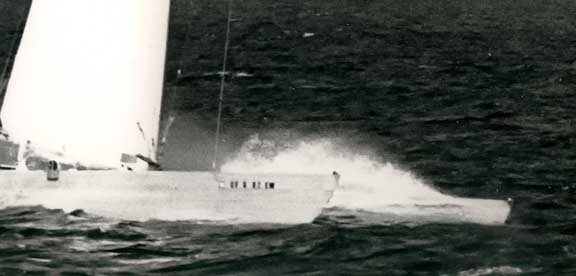
Here is a close up of the bow during the record run. The deep immersion of the V’d shape locks the hull on course. This was not a good characteristic (and isn’t today either on mono or multihulls).

Speaking of records, in 1974 we upped the speed to 35.59 MPH. Norm Riise (middle) and Hobie Alter (forward) were along for the ride. This doesn’t sound so fast now when windsurfers do 50MPH or more with regularity. But it seemed pretty hot in 1974!

A growing family brought the need for more cruising space. Beowulf Vl was the result. Note the rocker and freeboard in this launch hoist photo at Cabrillo Beach Yacht Club in San Pedro Harbor. Rather than have reserve buoyancy, Vl was designed with all her required floatation at the waterline. She was optimized for sailing on the leeward hull, and driving that hull through rather than over the waves. A key design element was steering control at speed.

That’s Beowulf Vl builder Rob Sjoestedt holding her off. Rob built the deck house and hulls in three months. The foam on the hull bottoms was faired by Mickey Munoz. Structural engineering was by Jerry Magarian, and Jack Jenkins helped with the metalwork.
All hull sections were semi-circular for minimum wetted surface.
We used Norm Riise’s VPP program, run during quiet periods on a mainframe computer at Jet Propulsion Labs, for parametric games on the various design trade offs (possibly the first instance of VPP use for yacht design). Another of Norm’s programs was used to shape the hulls. This was in 1974.
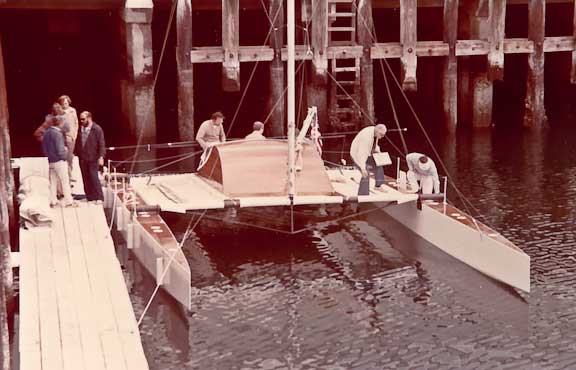
Inspection day. Aside from a nice family cruiser we desired to race with the big guys. ORCA controlled the offshore racing in Southern California, and we were anxious to try our hand at official distance race records.

This is the entire board or ORCA giving us an inspection to see if we were fit to race with them. We had life lines, auxiliary power, a full cruising interior, and required safety gear.
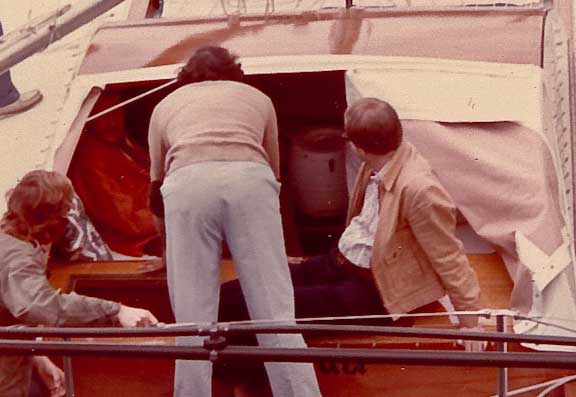
Vic Stern’s biggest concern was the size of the Portapotti seat. In spite of Vic’s concerns we were given conditional approval.
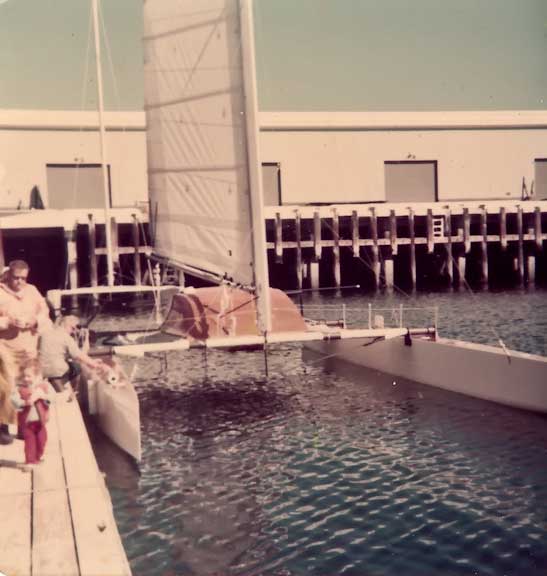
Beowulf Vl was 38 feet long, 18 feet wide, and weighed in at 2114 pounds in ocean racing/cruising trim (just 1700 pounds in day sailing trim). The hulls weighed 375 pounds each, were solid foam to the load waterline, and segmented into eight watertight compartments.
That is Norm Riise in the shades. We made the mistake of pushing off the dock and reaching down the channel while the ORCA board was still on hand. A new meeting was convened and we were put on probation for a year, theoretically eligible for elapsed time records, but not handicap results

Linda, Sarah (middle) and Elyse (right) ready to go cruising.
Off the wind Beowulf Vl would average twice wind speed until about 12/13 knots TWS. She could be easily steering in the puffs making it possible to average 20+ knots in 12 knots of breeze. We would regularly run over to the Isthmus at Catalina for a hamburger in 45 minutes from Los Angeles harbor. The return averaged 39 minutes (19 nautical miles). The mainsail traveler control was always hand held.
At the time we felt this was a big, relative safe cruising boat, in the right hands (ours). We’re not so sure we’d take our two babes to Catalina today in a boat that would capsize in seven knots of wind.
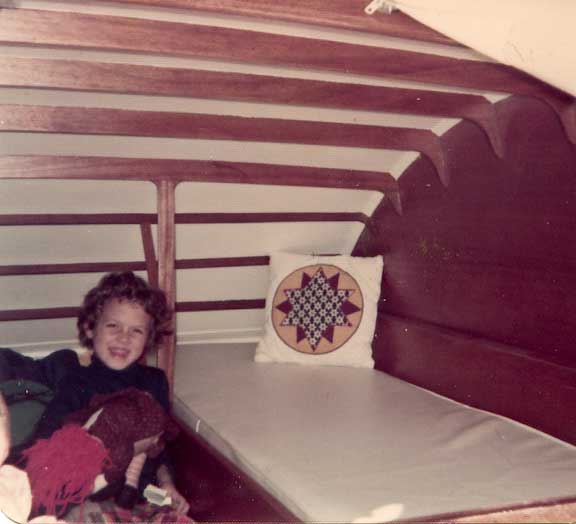
Elyse and Raggedy Ann show off our “great room”. We had two bunks, a stove and ice box, and the aforementioned Portapotti. What more could you ask?
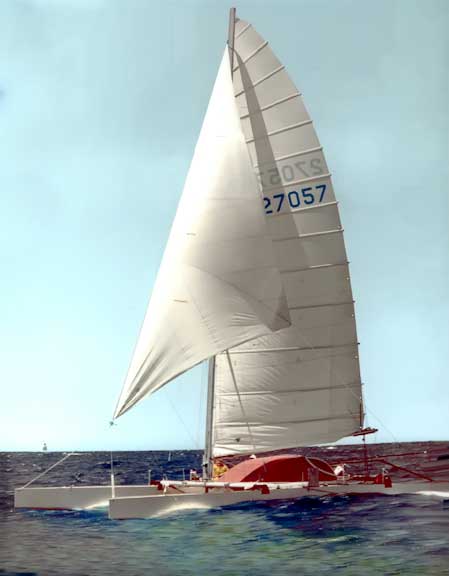
The beginning of the end of one life and the start of another. Beowulf Vl broad reaching after the start of the 1975 Ensenada Race.
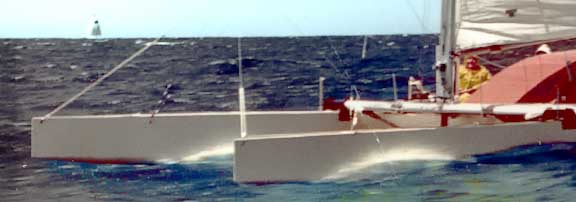
Compare this photo of a pressed bow to the earlier photo of Beowulf V during the 1971 speed trials. It is easy to see why Vl was so easily steered. We think the Alinghi designers have stolen our bow (just kidding).
We are averaging 26 knots here, flying our jib top of 300 square feet (the main is just 500 square feet). We covered the course in ten hours and fifteen minutes, breaking Aikane’s 20 year old official record by four hours.
A combination of racing politics and an interest in cruising kindled by this yacht gave us the impetus to sell our construction business, buy a leadmine (50 foot monohull) and go cruising. The rest, as they say, is history.
Post Script:
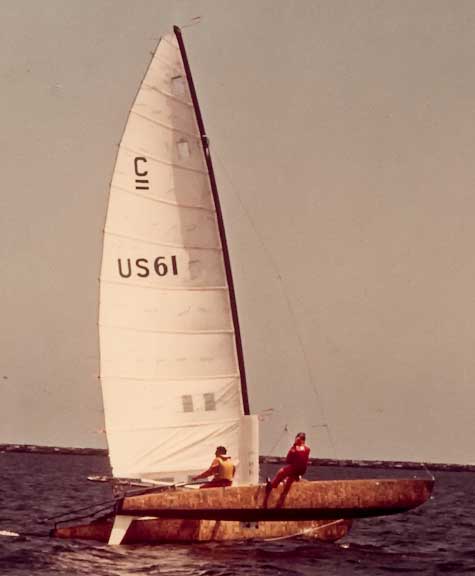
Beowulf lV is an interesting footnote in multihull design history. She was built on a Bob Riise designed C-cat hull and built by Bob Noble of six ounce boat cloth on either side of 1/4″ end grain balsa. As a C-cat, she was 25 feet long, 14 feet wide, and carried 300 feet of sail, all rule maximums. Wing masts were coming into play and we were trying out a different approach. We used an eight inch diameter thin walled aluminum pipe as a spar, with two sails forming an asymmetric airfoil.
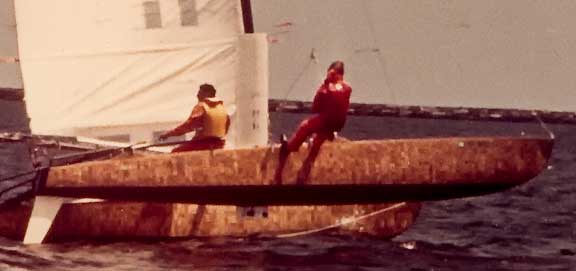
Daggerboards were asymmetric, NACA laminar series sections, canted to provide vertical lift to the hull leeward.
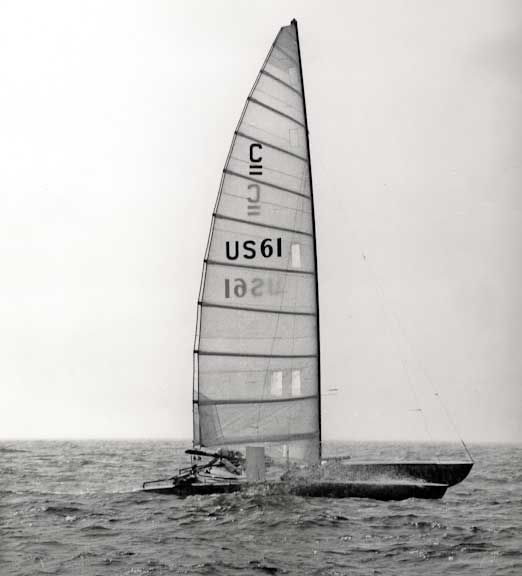
The clews of the two sails were attached to a bar which rotated, automatically flattening the windward sail and making the leeward sail more full.
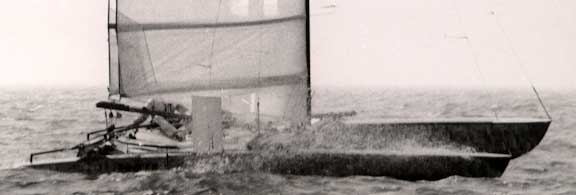
The daggerboards did provide lift, but had two drawbacks. They should have been further forward to help keep the bow up. The bigger problem was tactical. With just two crew the boards were awkward to deal with during starting sequences and mark roundings (the weather board had to be raised).
In a straight line the rig and boards on occasion provided astonishing performance. But we never learned to keep her consistently in the groove. Beowulf lV met an untimely demise during a Yachting Magazine One-Of-A-Kind regatta on Lake Michigan. She pitchpoled in a northeaster and was a total loss. Her remains provided the basis for Beowulf V.

December 21st, 2009 at 8:11 am
Hello Steve,Thanks for the pictures,from the looks of them I have Beowulf VI in my backyard.38 ft.same hull design.I have most of the parts,2 hulls,rudders,2 dagger boards,mast,sails & boom.Some rigging,I need the crossbars to hulls & mast connection and trampoline as well as tiller assembly. Any drawings with specs.would be much appreciated.I’m trying to restore her to original condition & sail in San Diego Bay.Anyone in the San Diego area that would like to contribute would be much appreciated.Thanks,Gary
December 21st, 2009 at 9:53 am
I’ll look and see if I can find the drawings. Not too hopeful though.
January 4th, 2010 at 7:32 pm
Hi Steve,
Beowulf (D) – US 1 is back in the water after a 4-year rebuild. It now has rounded carbon decks, a carbon mast and a new sail. One of the original hulls buckled on the Ditch Run (Berkeley to Stockton). You may also remember that the starboard hull broke off at the main beam and is stitched back on with kevlar strands. Now, I am looking forward to a year of racing on SF Bay and in the Delta.
Alan O’Driscoll
January 5th, 2010 at 4:04 pm
Hi Alan:
Hard to believe Beowulf V is still going forty years later! We’d love to post some photos.
January 5th, 2010 at 4:07 pm
Hi Alan:
I am not familiar with the LED spots to which you refer. Can you send us some info?
Thanks
January 6th, 2010 at 6:16 am
Hi Alan & Steve, Would be great to check out Beowulf V and see what you’ve done with the rebuild!Please send any photos or info you may have.Also where your located in SF Bay.If your ever in the San Diego area I live in Encinitas,Ca.Trying to do a complete restoration of Beowulf VI.I ran into Mickey Munoz at a Surfing event he said he had worked on her.I guess he shaped the foam hulls? Thanks for any info you may have! Gary Young (760)809-0749
May 16th, 2012 at 12:44 pm
Hello,
My father, Jim Adelman, and David Doich of NY bought Beowulf V from Steve soon after that picture was taken in 74. It was the only time the boat had an East Coast presence. I believe it was sold back to one of the original builders not too long after. I have many pictures of the boat plus updated pictures when I saw it up in San Francisco in 1997 during the Velejo race. If you want them I can scan and email them to you. Let me know.
Sincerely,
Greg
May 16th, 2012 at 3:52 pm
Thanks for the contact and please give our regards to your Dad. We’d love to see some photos, and maybe post them for historical purposes. By the way, the current (long term) owner has continued Beowulf V’s winning ways regularly whipping the more recent hot shots, teaching them to respect their elders.
July 1st, 2012 at 4:30 pm
Watching the “so-called” Americas cup trials, in what looked like “D” cats,today on NBC, couldn’t help but think back to the mid 70’s when you were ripping around Hurricane Gulch in your big D Cat. I was CBYC race chair back then and had to put the skids on the Pacific Multihull Asso. for not belonging to any yacht clubs that bore the cost of racing. Didn’t make me very popular but the Tornados, P cats and Prindles, etc understood and backed me. Racing sure isn’t what used to be back then!!
Best to you and yours,
Mike
July 1st, 2012 at 5:26 pm
As I recall, you and your family took off in a Columbia 50 so you might understand why I think that the most exciting sail boat racing that I ever watched was when Dennis went down to Perth and took the Americas Cup back in his 12 meter in 4 straight. ESPN did the absolutely outstanding coverage of the entire series with Jim Kelly and Gary Jobson. I understand that it’s all about speed and money these days but for old guys like me, watching a 12 meter make a pass on a reach and win a tacking duel, rounding the weather mark with a jibe set was breathtaking. Guess I’m showing my age (81)
Me again, Mike Kennedy
June 27th, 2013 at 8:32 pm
Hi Jerry, do you remember me from Multihull City w Bob Harris and Mike Eaton. Wally White and I were building 46′ Trimarans next to each other on the SE corner of the building. Wally’s gone now and I live in Oregon, I treasure the lessons in Engineering you gave us. I often wonder about all the guys that were building boats there. Drop me a note!!Rowland Smuck
rsmuck31@gmail.com
541 673 1245
October 18th, 2013 at 6:56 pm
Great remembering the various Beowulfs and being part of the great scene back in the late ’60s and early ’70s. I remember being along for the “shakedown” cruise aboard VI and spending the most terrifying – and exhilarating – sail of my life going from Cherry Cove on Catalina to Angel’s Gate in 50 minutes. The leeward bow would go under and stay there. You could tell when to ease up by how dark blue it turned. The sheet of spray coming off the bow would rival the rooster tail of any top-fuel hydro.
As has been observed here before, there’s not much new under the sun. With this A-Cup and its ancillary events, everyone thinks fast cats are so new and revolutionary. But except for the foiling, Southern California was a hotbed of catamaran innovation 40 years ago, and the only ones who seemed to care were the guys being pounded on the race course and inventing new ways to disqualify the cats.
I’m sorry to report that my father, Norm Riise, passed away on Monday, October 14, 2013, at age 98. He had a long and eventful life, from flying fighters in World War II off a series of aircraft carriers in the South Pacific, to working on many facets of the unmanned space program during 35 years at JPL, to running his own solar energy company, to designing, building and racing fast cats. He was particularly proud of Aquarius V, a C-Class that was sailed to victory over the Australian boat, Miss Nylex, in 1976 in the Little America’s Cup. It was the first American boat to win this event since its inception in 1961. As Steve mentioned, Dad borrowed time on the JPL computers (which in those days filled a room) to run the VPPs. He also obtained weather reports for the venue going back 10 years. What he discovered was that, during the month of racing (I don’t remember what month, and can’t seem to find it), the wind blew over 12 knots only one day in three. For lots of reasons, he didn’t particularly like the idea of a hard sail, like that on Miss Nylex. But he figured out that if the wind blew under 12, a soft-sail boat would be favored. If it blew harder, the hard sail would dominate. So he made the call to put a soft sail on the wing mast of Aquarius. The race went the full best-of-seven, and sure enough, in lighter breeze Aquarius went better. On the last day, it was light, and she won. Of course it was due in no small part to owner/skipper Alex Kozloff (who passed away only a couple months ago) with Robbie Haynes on the wire.
Alex later went on to build a sistership to Aquarius V named Carbon Copy – both because it was an identical boat (but lighter) and because, unlike Aquarius, it was all carbon fiber. Alex rarely missed the opportunity to note that, to his knowledge, it was the first boat ever built completely of carbon fiber.
October 19th, 2013 at 2:47 am
John: Sorry to hear of your Dad’s passing. Norm was an inspiration to us and many others with his unfailing good humor and endless patience. He was also the unsung developer of the very first VPP programs as well as software for hull design as well as rudders and daggerboards. Our condolences to the family.
October 19th, 2013 at 1:45 pm
Hi Steve,Great to hear about the “glory days” & the mulltihull history! I am still working on restoring Beowulf VI to original condition and back in the water.Could use some funding & supplies. I sent you some pictures of Micky Munoz shaping a Hobie surfboard and met Hobie’s daughter.She said he’s doing ok. They are planning an event book signing at http://www.surfingheritage.org in San Clemente. Also,ran into Phil Edwards in Dana Point. Had him sign my 51 Ford Woody! Take care,& Aloha’Gary
March 6th, 2014 at 8:09 am
I am writing a book : on the history of the International Catamaran Challenge trophy,
“Little America’s Cup“ history (in English and French) for the next even in Lac Leman in 2015 (last in Falmouth sept. 2013).
I research the lines, deck and sail plans of all the boats.
As in my others books, I redraw all the contenders.
The book will be published by La Martiniere at the end of this year, so I am in a hurry
Thanks to say me if it is possible to get sail plan, deck plan and lines plans of C-Class Beowulf IV
March 9th, 2014 at 2:49 pm
Hi Francois:
We have sent along what data we have on our C-class catamaran, Bewulf lV. In a couple of weeks we will do a post with details on this evolutionary C-Cat.